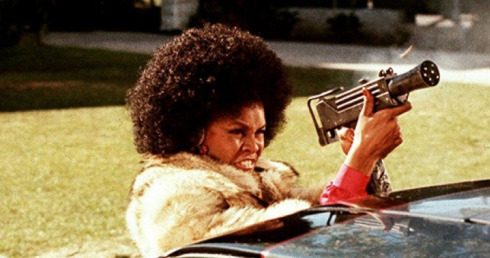
The following notes on Cleopatra Jones were written by Samantha Janes, PhD candidate in the Department of Communication Arts at UW-Madison. An original 35mm Technicolor widescreen print will be screened as the final of three programs celebrating three great performances of the 1970s. The movie screens at the Cinematheque on Friday, Feb, 28, 7 p.m., in our regular venue, 4070 Vilas Hall. Admission is free!
By Samantha Janes
“Look out James Bond, John Shaft, and all you other super-dudes, here comes Cleopatra Jones!”
Dressed in a hooded, long fur cape, all 6’2’’ of former model Tamara Dobson, who plays the titular role, immediately captures audiences’ attention in the opening scene as the camera tilts up to reveal her staring straight ahead. This is Special Agent Cleopatra Jones and in director Jack Starrett’s 1973 picture, she is just as prepared as Bond or Shaft to fight crime. During her mission in Turkey to destroy a poppy field that is being used to make drugs sold across the world, Jones sparks a war in her old L.A. neighborhood that leads to collisions with the police, drug pushers, and ultimately, the drug queenpin “Mommy” (Shelley Winters). Armed with gadgets, guns, and government protection, Jones sets out to prove that “she’s ten miles of bad road for any hood in town.”
Hoping to capitalize on the success of other Blaxploitation films like Shaft (1971) and Super Fly (1972), co-screenwriter, Max Julien originally pitched his idea of a Black female Special Agent to Columbia Pictures. The company was interested in a Black woman lead, but pushed to change the film into a comedy, which Julien refused. He then pitched the idea to American International Pictures (AIP), known for their distribution of Blaxploitation films. Personality clashes and faulty negotiations led to AIP losing the film’s rights but sparked a desire in the company to produce a film with a Black female lead and swiftly led to the production of Jack Hill’s Coffy (1973), starring Pam Grier. While the race to the box-office was won by Coffy, which premiered two months between Cleopatra Jones, both serve as two of the first Black woman-led exploitation films of the decade and offer the stars a new opportunity to showcase their physicality in both action-packed and comedic moments.
While Coffy was written specifically for Grier, Julien originally conceived the idea of Cleopatra Jones for his long-time girlfriend Vonetta McGee, who had appeared in Blaxploitation films like 1972’s Hammer and Melinda. After the change in studios, the role was opened to a larger casting call across the nation. The Warner Bros. pressbook for Cleopatra Jones (viewable thanks to the WCFTR’s Media History Digital Library) notes that the nation-wide casting call resulted in over 2,500 actresses auditioning for the role. In a 1973 interview with The New York Times, Dobson revealed the final ten actresses in the running for the role included both McGee and one of Dobson’s modeling rivals Naomi Sims. At the time, Dobson’s resume was shorter than her competitors, containing mostly modeling commercials and only two acting roles, one of which was as a stuntwoman for Come Back, Charleston Blue (1972). However, her lack of name recognition was made up for by her towering height, physical strength, and eagerness to take on the role. Her physical stature eventually became part of the film’s marketing and was included on the main tagline “6 feet 2 of Dynamite.”
Still, crafting the role of a Black female Special Agent took time and drew inspiration from numerous sources. The part of Special Agent Cleopatra Jones is one that Hollywood Studio Magazine called a “coveted role of the James Bond type.” Like Bond, Jones does not hide her identity but adopts a certain level of fame in her industry that results in her name being well-known across the world. A skilled martial arts fighter, expert in numerous weapons, and seasoned driver of her ’73 Corvette Stingray, Jones was a new type of Black screen heroine. Unlike Bond’s more subtle attire, Jones’s costuming provides her with a hypervisibility that announces her unique classification as a Black woman action star. Dobson’s degree in fashion paired with designer Giorgio di Sant’Angelo’s vision, produced ten radically different outfits for Jones in the film. Even when she is in a high-speed car chase or karate kicking a crooked police officer in the head, Jones is dressed to impress with fur boots, sheer shirts, and silver jackets. Though her hair is often hidden by a head covering during fight scenes, her afro wig and natural hair are both styled throughout the film when Jones is with her lover Reuben Mason (Bernie Casey) or friends in the neighborhood. Unlike Pam Grier as Coffy, Cleopatra Jones is never seen in any state of undress. The distinct lack of nudity and no sex on screen separates the film from other Blaxploitation pictures of the 1970s. Dobson states that there was no sex because they “wanted a PG rating and because Cleopatra Jones is a lady.” While sex worked well as a theme in other Black-led films, the emphasis in Cleopatra Jones always remains on the action.
Two years after the success of Cleopatra Jones, Warner Bros. released a sequel titled Cleopatra Jones and the Casino of Gold. Although the film did not achieve the same popularity as the original, this sequel saw Dobson return as Cleopatra to fight criminals in Hong Kong for her last leading film role. By 1975 the enthusiasm for Blaxploitation films was lowering, but overall, the Black-led films of the early 1970s labored to established new roles for Black stars. Now, over fifty years after the film’s premiere, Cleopatra Jones still resonates in Hollywood sparking discussions of a possible reboot written by Misha Green, showrunner of Lovecraft Country. Though Cleopatra Jones did not get to be the first Black woman-led action film of 1973, the film remains an enduring testament to the creativity of pioneering Black-led narratives during the 1970s.